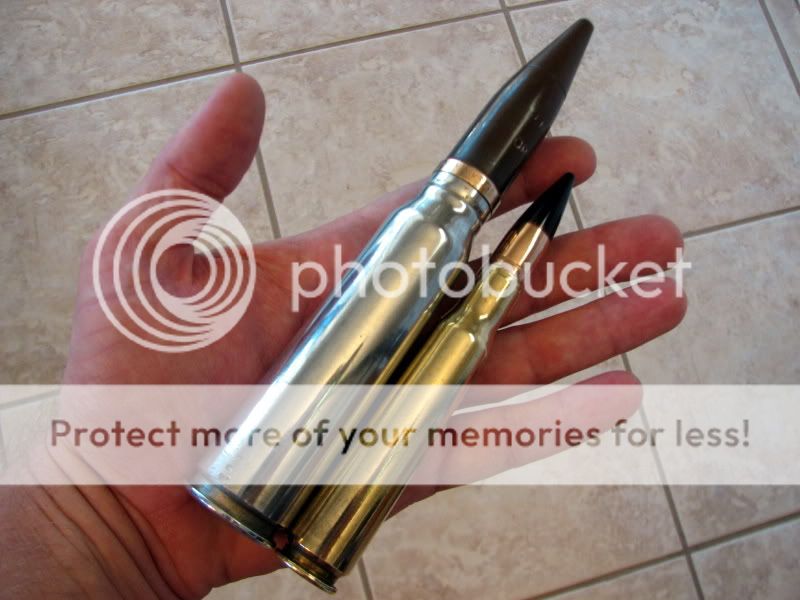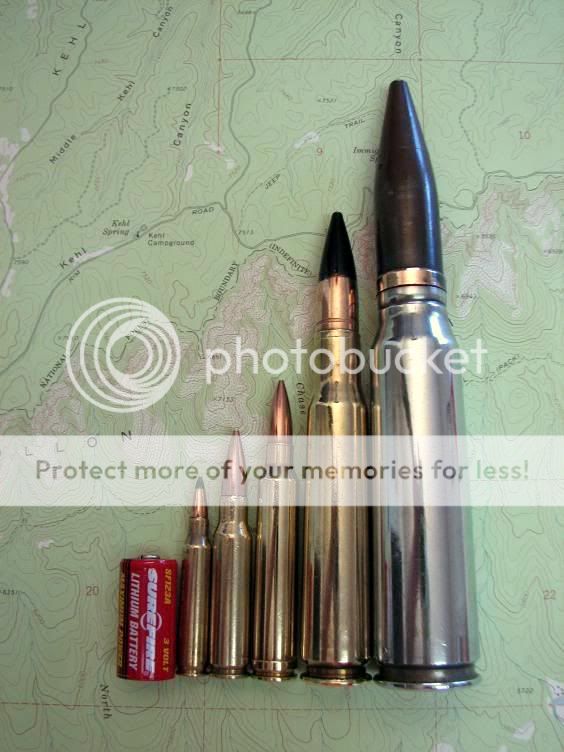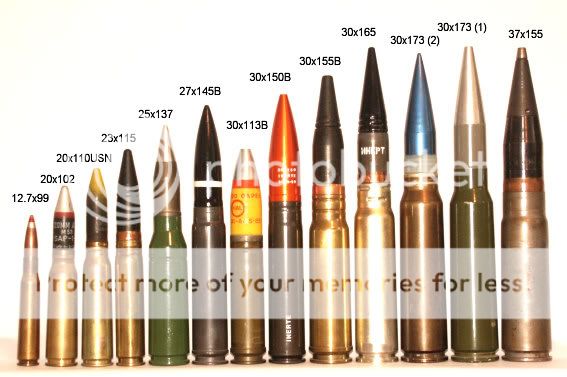Re: .50BMG vs. 20mm
This Thread used to be the .50BMG vs. 20mm thread, but I've changed the title to discuss all things "heavy metal." Tanks, artillery, military aircraft, warships, or any of the ordnance they use is up for discussion here. 
EDIT: 8-24-09
Posts 1 and 2 have been reversed so that the index appears up to. This post was originally the first.
Old vs. New Aircraft Armament
I'm not sure how many people will find this interesting but I know we have firearm enthusiasts here and probably a few airplane and technology buffs too.
I happened to be reading up on WWII aircraft, as anything associated with military hardware is one of my past times. Aircraft, tanks, artillery, ships, are all fair game. I happened to look up at my book shelf at an assortment of ammunition sitting up there and I wanted to better understand the advantages of a single Gatling-style aircraft gun as compared to multiple, single barrel, heavy machineguns, like the systems used in WWII and Korean era aircraft.
Having fired at least a thousand rounds from the M2 heavy machine gun I'm always impressed with the energy it's able to deliver down range. 50BMG can crack and zip through engine blocks, crush brick and granite and chews down stacks of sand bags like no other small arm can. It's almost funny that it's considered a "small arm" as it's really in a whole different category from anything else I've experience in portable full-autos weapons or even larger tripod fired machine guns like the Vickers, Browning .30, or MG42. I'm amazed to think of the firepower when 6 or 8 forward firing M2s were combined in aircraft to concentrate their firepower onto one spot. Having said that I've got to think the GE M61 type Vulcan must be one heck of a weapon system that it could replace 8 M2s firing at 800+ rounds (non boosted) per minute each.
I wanted to see if I could put to paper some calculations to help me see the differences more clearly and that's mainly all this thread is about.
Lets start with the specifications of each gun type.
Browning M2 Heavy Machine Gun. (AN/M2 for our example)
Recoil operated. (short recoil technically)
Air-cooled
.50 MBG
750-850 rounds per minute (non-boosted)
84 lbs
http://www.fas.org/man/dod-101/sys/land/m2-50cal.htm
http://en.wikipedia.org/wiki/Browning_M2
General Dynamics M61A2 Vulcan (Previously a General Electric product)
Pneumatically or hydraulically operated
Six-barreled, air-cooled
20mm PGU-28
4000-6600 rounds per minute selectable
202 lbs (A2)
http://www.fas.org/man/dod-101/sys/ac/equip/m61.htm
http://en.wikipedia.org/wiki/M61_Vulcan
http://www.youtube.com/watch?v=Gn9Lp...eature=related
A look at each cartridge.
.50 BMG
622 grain API round (frequently used at that time in fighter aircraft)
2910 feet per second muzzle velocity
20mm PGU-28B (previously the M50 series)
1543 grain (3.5oz) (100gram) semi-armor (soft core) piecing high explosive incendiary
3450 feet per second muzzle velocity
The two rounds (this particular 20mm is of the 50 series not the low-drag PGU) very close to actual size.
…and another which you flashlight folks can relate to. (very close to actual size)
Left to right, CR123, .223, .308, .300WM, .50BMG, 20mm
A look at each aircraft:
I wanted to use the P-47 Thunderbolt because it was one of the most heavily armed fighter aircraft of its day with 8 x .50cal M2s, four in each wing
http://en.wikipedia.org/wiki/P-47_Thunderbolt
I'll use the F22, and F18E since they both use the A2 variant of the gun. The A1 variant had more rotating mass and thus limited the gun to about 6000rpm. The A2 because of its lighter weight barrels has the side benefit of increasing the rate of fire to 6600rpm.
http://en.wikipedia.org/wiki/F22_Raptor
The math:
I'm going to keep this simple because I'm not very good with math and although I can calculate muzzle energy I'm not interested in doing that. Instead I'm going to use a "Power Factor" (PF) formula, which uses the weight in grains of a given projectile x its velocity in feet per second.
Now there are all sorts of different loads available for every caliber so you ballistics gurus can settle down if it looks like I've undercut the performance of your favorite cartridge…lol. Obviously hand loading certain calibers, especially in the case of rifles rounds will usually allow for more performance. I'm simply going to use some generalist examples for Power Factors of well-known small arms ammo to set the stage for the big boys.
Power factor charts (weight x velocity)
If the numbers seem to big, just abbreviate them by dropping what's behind the first decimal. As you can see, the 50BMG and 20mm rounds are in a class of their own.
.22 Long Rifle 46,000
9mm Luger 142,600
.40 S&W 180,000
.45APC 207,000
.357 Mag 221,000
.44 Mag 336,000
5.56 x 45 170,500
7.62 x 39 282,900
7.66 x 51 382,200
300 Win Mag 540,000
.50BMG 1,810,020
.20mm 5,326,350
In order to compare the relative performance of 8 x .50 caliber guns to the 20mm Vulcan we have to multiply the firing rate of a single gun x 8.
8 x M2
800 round per minute x 8 guns =
6400 rounds per minute
M61
A single M61A2 fires at
6600 rounds per minute
Now we multiply each gun's rate of fire x the energy of each individual round, but first we'll reduce the numbers since they become too large. We'll convert grains to lbs for that.
.50BMG
622grain x 2900fps =
1,810,020 (PF)
622 grain = .088 lbs
.088lbs x 2910fps =
256.08
.20mm
1543grain x 3450fps =
5,323,350 (PF)
1543 grain = .218lbs
.218lbs x 3450fps =
752.10 (roughly 3 times the energy of the .50BMG)
Conclusion:
Since 752.10 divided by 256.08 = 2.94, it's about right to say that the M61 produces 294% more gun energy than a P47 with 8 x .50cal M2s. In other words it would take 23.52 M2 machine guns to match the firepower of a single M61. This only applies to muzzle energy, since the more range increases the more the gap will grow between the two due to differences in retained energy.
Just for fun, let's look at the weight of projectiles leaving the aircraft. This of course doesn't factor in velocity, only projectile weight per second at each caliber's respective speed.
8 x .50BMG
6400 rpm divided by 60sec = 106.67 rounds per sec x .088 lbs =
9.39 lbs per second of projectiles
20mm
6600 rpm divided by 60sec = 110 rounds per sec x .218 lbs =
23.98 lbs per second of projectiles
[FONT="]That's it for now. Later I'm going to compare the GAU-8 30mm gun, (the one the A-10 Thunderbolt II / Warthog) to the GAU-19 tri-barreled .50 caliber, which is rumored to replace the commander's M2 on a few M1A2 SEP tanks for testing. [/FONT]
__________________
-Patriot- "Government is not reason; it is not eloquence; it is force. Like fire, it is a dangerous servant and a fearful master." -George Washington-





